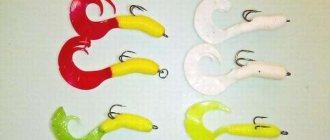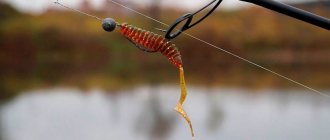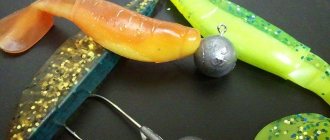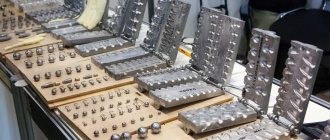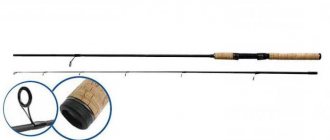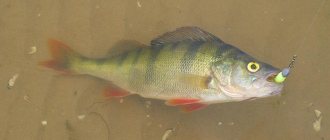Fishing with Cheburashka is a promising activity, as it allows the spinner to search for prey at different depths, currents and locations.
The cartoon prototype of the Cheburashka entered the life of every fisherman and became his favorite hero. What does Ushastika have in common with a man’s occupation? How can this piece of equipment affect the amount of catch? What features, forms and rules for choosing sinkers exist? What is it made of and is it possible to independently produce such a popular head weight at home? We will answer all these questions in this article.
Cheburashka cargo: general description
A Cheburashka weight, a Cheburashka jig head or an eared sinker is an element of equipment that has two loops on its body, called “ears” in the fishing world, which serve for mounting a carbine with a fishing line or bait in the form of a wobbler, edible bait or hook of various configurations, in including double and tee.
For more information about what a sinker is, what its purpose is and what features this element of equipment for jig phishing has, read here
Jig bait
Well, and of course, what is jig fishing without bait? Entering a fishing store, a person will see huge stands with rubber for every taste and color.
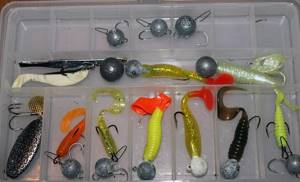
All baits can be divided into 2 broad categories:
- active;
- passive.
Active baits include various twisters and vibrotails. They have more energetic and frequent play. Passive baits include various types of crustaceans, spiders and even lizards.
There is also rubber with a smell. The most popular are: shrimp, anise, squid. Many fishermen are skeptical about scented baits, believing that the smell has no effect on the number of bites and may even, on the contrary, scare away the fish. Other fishermen use odorous rubber for a very passive predator, when the fish need to be provoked to bite using a variety of methods.
Since baits come in completely different colors, here you also need to know some rules by which you should choose rubber when fishing. It should be said that in sunny weather you should not use too bright colors, such as red and orange. They will be too noticeable in the water. In cloudy weather or when fishing in muddy water, these colors will be just to the taste of the fish, since they are visible from quite long distances.

If you have a specific goal in catching a trophy, then you shouldn’t skimp on bait. Professional fishermen set baits of 15-20 centimeters and successfully fish with them. It often happens that a large pike weighing 7-8 kilograms won’t even look at a 5-6 centimeter bait. Here everything is like in the saying “a big piece and the mouth rejoices.”
Rubber can be made from completely different silicones. One may be hard, while the other will be easily crushed by your fingers. The softer the silicone from which the bait is made, the more natural the play in the water will be. But soft material also has its disadvantages. It will not be as durable as a hard one. After each fish bites, the bait will acquire more and more bite marks, and eventually some fish will tear it completely, which means that the fisherman will be forced to change the bait.
But do not forget that harder silicone baits will not play as well in still water as soft ones. Therefore, for each reservoir it is worth selecting the nozzle individually. For strong currents, it is worth installing such hard silicones.
Read more about how to properly attach a vibrating tail to a jig head and other equipment.
Vibrotails and twisters have gained the greatest popularity among fishermen. For many, they are the best jig baits. They have a tail in the form of a small blade or crescent, therefore, due to this, even with the slowest retrieve they will play quite energetically. It is worth placing the bait on the jig as evenly as possible so that the vibrotail in the water looks like a feeding fish.
Advantages and disadvantages of Cheburashka cargo
Let's figure out why this particular type of sinker has gained respect and love from anglers of different ranks.
“Cheburashka” is one of the components of the hinged mounting equipment, which has a number of advantages and capabilities:
- The ability to perform long casts due to the weight of the load, which during flight always ends up in front of the bait and this position eliminates “helicopters” (overlaps), which are so common when rigidly mounted with a jig head, when the sinker rotates around itself in flight. Also, the range is ensured by placing the bait behind the load, which reduces its windage and increases its flight.
- Thanks to the presence of ears, it is possible to quickly install equipment at any stage of fishing.
- Possibility of equipping such cargo with different types of hooks.
- This equipment is reliable when landing fish.
- It goes through snags well, and in combination with an offset hook, it copes with snags.
One of the advantages of installing a Cheburashka with a hook is that it performs well when fishing for prey, but installation can have a negative impact when hooking it, when a rigid hitch with a jig head is considered more effective. This is a minus of the Cheburashka, which can be easily dealt with in amateur fishing, but in sports it is a significant drawback. Also, installation with a Cheburashka is more difficult than with a jig head.
Let's talk about little things - “Cheburashkas in the Ultralight class”
This note is dedicated to all ultralight lovers, namely those people who cannot imagine their fishing without a microjig.
I am also a member of these ranks, and microjigging in ultralight fishing takes up almost all of my time! After all, this type of fishing allows you to catch a completely different variety of fish! I would say that everything that swims in our reservoirs is successfully caught with microjig.
The main installation used in this class of spinning rod is a hinge, namely a Cheburashka and a single hook with a large ear, or an offset hook; doubles are used extremely rarely.
Today we will talk about such consumables as Cheburashkas. Like most spinning anglers, in my fishing I use lead cheburashkas, usually of the collapsible type, because it is very convenient to insert a hook into them, be it single or offset.
Of course, trying to minimize fishing losses, but I catch a lot 3, 4 days a week! I preferred lead Cheburashkas, and as a rule at the lowest price. I have been using Cheburashkas for several years. Among their advantages, I would attribute the fairly thin wire and a very low price compared to other manufacturers. The thickness of the wire allowed the hook, even with a narrow ear, to sit freely and not get stuck on the ear itself during sudden movements. Of course, I was very confused by the quality of the products themselves, and their weight difference from 0.1 to 0.5 grams! So the same declared weight of 2 grams could weigh both 1.8 grams and 2.3, of course, this is the merit of the “finishers” in production, and of the casting technology itself. On the whole, this suited me, but when the “Tula Cheburashki” in small weights came into my hands, I, of course, forgot about the products.
The tufts were distinguished by very good casting quality, calibration, and I also really like the wire used in these Cheburashkas. Well, the variability of the scales also impresses.
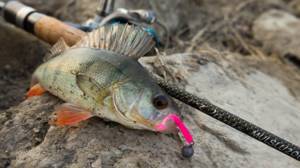
The only “but” is the price of Cheburashkas; nevertheless, a product made of lead weighing 1 gram should not cost 12 rubles, like the same product weighing 12 grams! But these are lyrics, you have to pay for quality.
At the moment, I have not yet found an alternative to these lead products.
For several years I didn’t even think about switching to weights made of any other material.
In the meantime, the tungsten “Boom” occurred, I’m not afraid of this word, which I was skeptical about, and continued to fish with lead, but at one fine moment golden tungsten Cheburashkas fell into my hands. At first I didn’t find anything in them other than an aesthetic component, but soon I radically changed my mind and bought more of these beautiful golden balls.
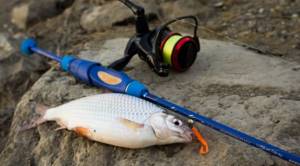
After the fishing season, which included not just amateur fishing, but also several competitions, I clearly formed the opinion that tungsten bites much better, the bites themselves are more confident, the fish reacts to baits completely differently than with a lead head, it takes more willingly and much greedier, and on days when the fish simply bit the lead bait, when switching to a golden or silver tungsten ball it was possible to catch a passive fish.
Why this happens, the answer, in my opinion, lies on the surface. The shiny bright head serves as an additional irritant for the fish, like the shiny crown on a black jig, perhaps being an attack point of some kind. Most likely, the knock on the bottom is louder and more distinct for the fish, at least the sound from lead and tungsten is different in the rod. Of course, I have not made deeper observations, and perhaps tungsten, when in contact with water, creates some kind of additional electric fields that make the fish bite, but this is all speculation. And of course, tungsten has a huge advantage, its flight characteristics, it actually flies further than lead, this is especially noticeable when fishing in windy weather.
As a result, by the end of the first season, I realized that I had almost completely switched to tungsten Cheburashkas, forgetting about lead.
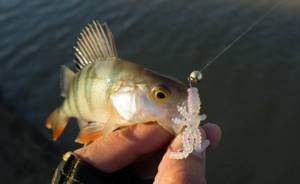
Now I only remember about it in places where there are a lot of cliffs, but the price of tungsten products is still very high. By the way, with tungsten in “natural” colors - closer to lead color, I did not notice any improvement in fishing results.
Of the companies that I have used, I would like to highlight the Cheburashkas from Eco-pro. They are sold in large packaging, up to 10 pieces, which is very convenient.
The ear on these Cheburashkas is made in such a way that the gap between the wire into which the hook is inserted does not look up, like most products, but down. In my opinion, this way it is much easier to insert a hook into them, and the quality of the products itself is at a very good level.
Summarizing today's conversation about the little things, I would like to say that any bait should be used expediently; I fish with tungsten in places where the number of hooks is kept to a minimum, and in places where Cheburashkas get stuck in a scattering of stones or windbreaks of branches, I fish with lead, somewhere more expensive and of higher quality , and somewhere for the cheapest.
Of course, tungsten is not a panacea or an “edible” Cheburashka, but the number of bites in properly sharpened hands increases, unlike lead heads.
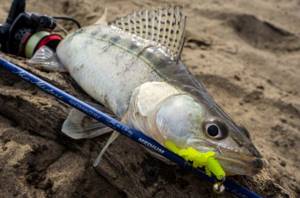
I would really like to know your experience of using tungsten cheburashkas in this class in the comments!
Sincerely! Sergey.
Cheburashka sinker shapes
The spherical shape is a classic and the most common in the fishing environment. However, many spinning anglers in their fishing practice prefer other improved forms of Cheburashkas, which are successfully demonstrated by the manufacturers of such sinkers.
Advantages of the classic form:
- With a small volume, they have maximum weight, which serves as a determining factor for long-distance bait throwing.
- Sinking quickly.
- It passes through overgrown “traps” very well.
- Shows itself well in depth and current.
The shape called “field” has a design feature in the form of flattened sides and an elongated body. The use of such a load is appropriate when fishing in a small body of water with characteristic bottom unevenness, both during flow and in calm water.

Planning sinkers have their own character:
- Slowly sink to the bottom.
- When reeling in, the fishing line immediately rises and floats above it, so it easily “jumps” over obstacles.
The fish head is a more expensive sinker, but is unremarkable and is not used often.
So most spinning players prefer the spherical shape of the Cheburashka.
Fishing technique
The resulting tackle is lowered to the bottom surface, after which the wiring itself begins. Hooks equipped with panicles greatly attract pike perch, and sometimes pike and perch. With any push from the depths, you should carry out an intensive hooking, and then immediately take out the caught trophy, otherwise it may hide in a snag.
The most interesting fishing with Cheburashka is where there is a strong current, as oncoming currents play with the bait. It should be noted that the existing equipment can be slightly improved. This is due to the fact that brushes provide good play only in fast currents, while in weak flows their play noticeably deteriorates.
Remaking the equipment comes down to the following - a frayed artificial fiber or a woolen tassel is similarly fixed to the forend of a double or tee, but instead of a PVC tube, a cylinder made of white hard foam is put on. Moreover, its length should be 30 mm, while the diameter should be 10 mm. This gives such a result that catching pike perch with a Cheburashka will be much more effective.
Read: Catching perch with bait that imitates crayfish
Sinker material
Typically, lead is used to produce jig weights at home, since this metal has a number of advantages, although it is inferior to tungsten in many characteristics.
Read about what material is best to purchase sinkers for jig wiring, the advantages and disadvantages of each of them, as well as what needs to be done to prevent oxidation of the head here
Types of jig heads for pike
There are two main types of jig heads for pike fishing:
- stationary jig heads;
- eared sinkers.
Stationary jig heads
A stationary jig head consists of a sinker and a single hook rigidly connected to it. It has two important advantages:
- during the animation of a jig head of this type, the hook is always positioned with the tip up, as a result, the probability of an effective hooking is maximum;
- The jig head provides better action for some lures, such as vibrating tail.
When a vibrating tail is attached to a jig head, it becomes rigidly fixed. In this case, the tail of the bait can actively play relative to the body. If you use a hinged mounting, the bait plays with its whole body, and the work of the tail turns out to be much less expressive.
Swivel jig heads
An eared sinker, also called a Cheburashka sinker or an articulated jig head, is a ball of metal with two ears. One of them is attached to the leash, and the bait is mounted to the other on the winding rings. The main advantages of installation with a Cheburashka sinker:
- the articulated jig head with bait has good aerodynamics, so it can be cast over a long distance;
- thanks to the hinged connection, the hook with the bait receives a greater degree of freedom, so a silicone or foam fish attached to the hook has a more attractive game;
- the likelihood of a pike leaving after hooking is less, while when fishing with a stationary jig head, the predator can use the hook rigidly connected to the sinker as a lever and free itself from the equipment;
- When fishing with a Cheburashka sinker, you can easily replace the hook with bait.
When fishing with a hinged mount, the equipment is folded during casting, and the hook with bait is pressed against the weight, which ensures the longest cast.
Hinged mounting during wiring provides a more attractive game for pike with twisters, passive silicone baits and foam fish. It turns out to be especially relevant when fishing with foam rubber and artificial fish made from floating silicone. During the pause, when the hook is hinged with the sinker, such a bait is positioned vertically in the water. With this animation, it reminds the pike of a fry feeding at the bottom, which can become an easy prey. In addition, due to its vertical position, the bait is better visible to the predator, and the chances of a successful hooking increase, since the hook is more likely to end up in its mouth after the bite.
How to choose the right cargo
Tips for choosing the ideal Cheburashka shape:
- Make sure that the shape of the weight is cast perfectly, since irregularities (bends, bulges, pits) will affect the behavior of the weight and, ultimately, the result of the catch.
- The seams must be neat, since under any load, if the connection is not perfect, the sinker will fly apart.
- If possible, the lead sinker should be painted, which prolongs its service life and protects it from corrosion or oxidation. However, this point is also negative, since marks from fish tracks are a kind of bite signal, and if the cargo is painted, such marks are not visible. On the other hand, the colored cargo can serve as an attack point for a predator. In this case, the choice of color is decided by the desire of the fisherman.
Tips for choosing a Cheburashka element - eyes:
- Make sure that the material used to make the ears (wire) is not thick and allows manipulation.
- Also, this material must be elastic and not subject to change under the influence of loads.
- Pay attention to the shape of the lugs and the quality of their manufacture, remember that they must be coated with anti-corrosion lubricant.
- Check the installation of the ears, it must be strong.
- Make sure that the size of the lugs is harmonious with the overall design and not too large so that the required installation can be performed.
- The size of the lugs must be sufficient (at right angles to each other) for unhindered installation of the equipment elements.
Next, after purchasing a good quality head, you should decide on the characteristics that will affect the catch:
- the shape of the load, which was described above;
- Cheburashka cargo weight.
Advice. For beginner spin fishermen, it is better to have weights with a 5g incremental advantage, such as 5g, 10g, 15g, etc. For more experienced people, a decrease of 2 g, or even 1 g.
You can read more about the weight characteristics of jig heads here
What time of year is perch caught with a jig?
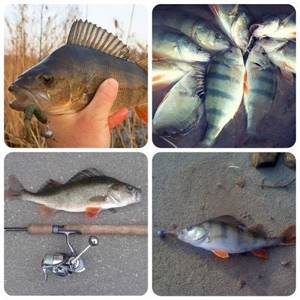
In autumn, this type of fishing is used most often, bringing good catches. At this time, the perch gathers in large schools and begins to move towards medium and greater depths. He has not yet gone to the wintering pits, fattening to the fullest, since the gluttony is in full swing. In late autumn, when the temperature drops, you need to look for it at greater depths, trying to find a suitable dump or hole.
If you want to catch a trophy specimen, you need to fish the bottom and bottom layer, so spinning rods are equipped with spherical Cheburashkas with rubber. Jig, in this situation, is the best solution. Experiment with the size of the bait, since large fish, in most cases, will not chase the fry on the surface, spending an incredible amount of effort.
Having settled at depth, in an area that will cover it, it will wait for fish swimming near the bottom. Favorable months for hunting humpback salmon are September and October; at this time it is extremely active. But as already mentioned, heavy jig heads and Cheburashkas should be used. Over the summer, the water level rises, the current increases, and it becomes more difficult to break through these conditions.
When choosing the weight of the load, you need to take into account the depth and current. On small and medium rivers there is no need to use weights of 30 g, often 10 g is enough, but again, the final choice is yours, based on the fishing location. The solution comes with practice, after a couple of test casts you will understand what to use. For example, in the autumn the wind increases, preventing you from casting a light Cheburashka of 4-8 grams, forcing you to use heavier weights.
In late autumn, in November, when the water temperature drops, the activity of all fish comes to almost nothing. Both weather conditions and the end of the meal take their toll; the next stage begins, when the fish move to winter pits and prepare for a long period of cold weather and frosts. It is during this period that it is best to be equipped with foam rubber and polyurethane foam baits.
Passive play will attract a predator much better than rubber vibrations. In spring, all rivers and lakes rise in level after the snow melts. The water is cloudy and you can hardly see anything in it. It takes time for all the excess to settle to the bottom and the view to improve. Don’t forget about the ban on spinning fishing during the spawning period, the duration of which is set depending on the region.
We will start from the fact that the ban has already been lifted. Full banks and fast currents dictate their conditions: the same heavy jigs are used. In summer, when fishing for perch, ultralight is often used. This is a light, small rod (1.80 - 2.0 m), with the same reel (1000) and thin cord (up to 0.1). The rod test sometimes does not exceed 10 grams, or even less. Small baits perfectly attract fish that are active during this period.
Jig tackle: how to choose and prepare it correctly
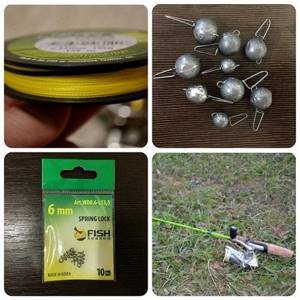
This method involves delicate and light gear. It does not use so-called stakes - rods that do not respond to jerks at all. When using such batons, there is no idea what is happening with the gear in the water column or on the bottom.
The main task that a spinning rod needs to cope with is to be extremely sensitive both during retrieving and during bites, for timely hooking. Perch have soft lips, so with a strong tug you can easily tear them off. In order for the fisherman to feel his rod, a fast or medium-fast action is selected.
Its length is determined depending on the fishing location. For small and medium-sized rivers, the ideal option would be a stick 1.8-2 meters long. This is a universal option, suitable for both shore and boat fishing. A rod with good SIC (for example) guides, a high-quality reel and cord makes it possible to cast long and accurately.
Plus, if you use branded, balanced baits, then you definitely won’t have problems with the casting range of a 1.8 rod. The reel is selected to match the fishing rod; when purchasing, it is advisable to be able to put it on a spinning rod, hold it in your hand, and evaluate the balance of this bundle. If the meat grinder is heavy, this will immediately become clear.
For ultralight jig, an ultralight reel with 1000 spools is used; a larger size is not necessary. Ideally, it comes with several spools: 2 aluminum or 1 aluminum with a plastic one; depending on the price and manufacturer, these can be different options. In this case, you wind braided wire on one and monofilament on the second.
Braided fishing line is set from 0.6-0.1 mm, despite the fact that 0.1 is the upper limit, you can also catch pike with it. It’s not uncommon for pike to attack perch baits, so there are times when it’s better to play it safe. The optimal option is 0.6-0.8 mm, everything will depend on the manufacturer.
For example, Japanese manufacturers of braided cords try to indicate the exact diameter on their products. There are quite frequent cases when the thickness is indicated on the packaging as 0.8, but in reality it is 0.12, and so on. Practice shows that the more expensive the manufacturer, the more the stated dimensions correspond to reality.
Wire and fishing technique used
- Uniform wiring. A suitable option for beginners. There is no need to have sacred knowledge to reproduce it. It performs well in the summer, provided that the baits used have their own game, in particular twisters and vibrotails. You can fish in any thickness of water, both at the bottom and at the surface. After casting, wait for the load to fall to the bottom and begin to evenly rotate the reel handle. In order to find out the performance of a particular bait, throw it to the shore and retrieval, observing its behavior. This way you will determine the optimal speed of rotation of the spool. With some experience, you will learn to move the bait just above the bottom without dragging it along it. Or, when planting slugs (worms), move straight along the bottom. Experiment and find an option that works today.
- Ryvkova. After casting the bait, expect it to sink to the bottom. You tilt the top of the spinning rod towards the water, starting to make short jerks, winding the cord in parallel. After the next jerk, a pause of 1-2 seconds is made and everything is repeated in a circle. The number of rotations of the coil, as well as the pause time, is selected experimentally. By choosing the best option, you will provoke the perch to attack.
- Stepped wiring. A classic method used everywhere by both beginners and professionals. In a nutshell, this is a rewind and a pause. The method is universal due to the fact that the spinner can vary the number of rotations of the reel with pauses of different durations. Typically, the pauses are shorter in warm water and longer in cold water. This is due to the different activity of the fish. Again, be sure to experiment. If, when falling to the bottom, the bait raises a lot of dust and turbidity, then it will be more difficult for the humpback whale to notice and attack it, so in this case it is appropriate to pause longer.
Collapsible Cheburashka
The main advantage of a collapsible Cheburashka is the ability to remove the wire eyes and thereby avoid difficulties when installing the factory ring as a connecting element with the hook at any stage of fishing. This manipulation is sometimes inconvenient to perform with an ordinary non-separable weight.
Disadvantages of collapsible cargo - under the influence of gravity, low-quality ears can pop out at the most inopportune moment.
Tip: it is recommended to store such sinkers in a box so that if the hooks slip out, they will not be lost.
Recommendation for strengthening the ears in Cheburashkas with thin wire - you need to squeeze the weight from the sides using pliers.
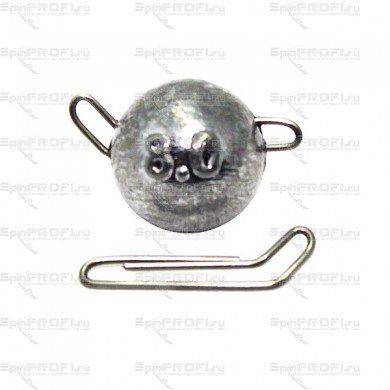
Many spinning anglers may have questions regarding collapsible lugs. For example, could the hole for extending the lugs affect the volume of the sinker? If you look closely, you will not see any changes in volume. Can the ears straighten? High-quality ears do not bend when additional load is placed on them. Can the thin wire of this eyelet cut fishing line (braided cord)? This situation is only possible when tying the wrong knot. For example, to secure the cord it is better to use a knot called a “clinch”.
The correct selection of jig heads affects the performance of the bait
The described problem also occurs for jig heads, but its manifestation is not so obvious. If you take a relatively large vibrotail and equip it with a jig head weighing 1-2g. The result will be disastrous... You can try it and see for yourself. But, in terms of vibrotails, this imbalance is not so noticeable. In addition, with obviously large weights of jig heads, the tail still plays well.
Here you should act according to the rule of minimalism. Set the smallest possible weight of the jig head, at which: A) the bait plays; B) Sensitivity is achieved by moving stepwise along the bottom.
Thus, the inch vibrotail played in the test with “Cheburashka” weights in the range of 2.5-4g. At 2g, there was no more game... At more than 4-5g, the game also deteriorated. Accordingly, larger vibrotails will have their own range. It is necessary to select the weight for each type of vibrotail. This means that for a specific place, with a specific depth and current strength, we will be forced to use a very limited set of baits. While jig heads will allow you to expand this range.
How to make a Cheburashka sinker at home
A video lesson on creating a mold from plaster and casting dismountable Cheburashkas will be demonstrated by the author of the channel “My Fishing”
A short video about making fasteners for dismountable Cheburashkas with your own hands from E. Yablochkin
Important! Before you start manufacturing, you need to know about the dangers of this metal on the human body and the environment. Read the article about the dangers of lead here https://www.vredno-vsyo.ru/index.php?newsid=147
International experience in combating the lead threat in fishing https://marine-fish.ru/era-svinca-podhodit-k-koncy-svincovye.html
What is a one-ear joint?
Fans of jig fishing have long been familiar with various “Cheburashkas”. Together with the hook, they create a jig rig with great freedom of action for the bait. But few people imagine what a one-eared joint is. This is the same Cheburashka, but with only one eye, on which the hook is mounted. A leash is also tied to this ear.

